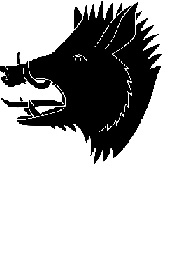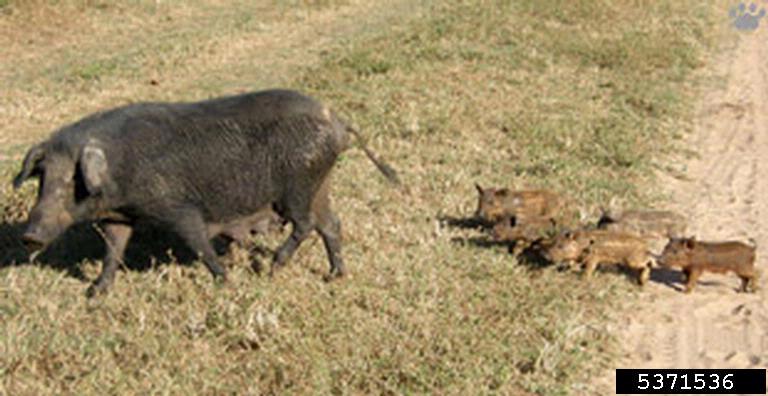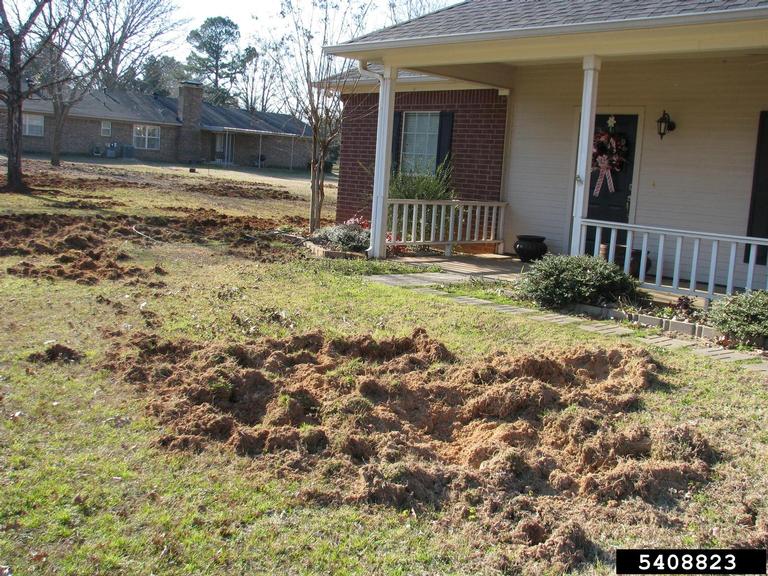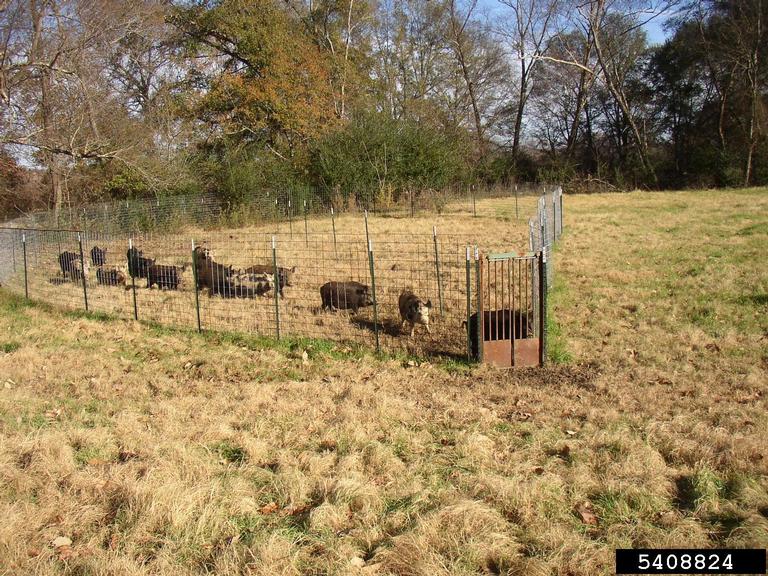 Feral Hogs - July 15, 2015 Jeff Schalau, Agent, Agriculture & Natural Resources University of Arizona Cooperative Extension, Yavapai County Feral hogs (wild pigs) are not javelinas. Originally, they were introduced to North America over 300 years ago by Spanish missionaries in California and Texas. Most are classified as wild boar (Sus scrofa), but escaped domestic hogs have also interbred with existing populations. These animals are very destructive to agricultural and wild lands. They can also harbor and transmit diseases and parasites to domestic livestock, wildlife, and humans. Feral hogs are known to exist on the Arizona Strip, San Pedro River Valley, Lake Havasu, Agua Fria River, Roosevelt Lake, and probably other areas too. The Agua Fria population has been sighted in the Dugas area – not far from the Verde Valley. Feral hogs usually live to be 4 to 8 years old, with high mortality rates among the young and the very old. Feral hogs are covered with coarse, long hair. Full-grown males are usually 200 pounds at adult weight, while full-grown females weigh slightly less and average about 175 pounds. Once juveniles reach 10 to 15 pounds, they are able to escape most predators. Females are sexually mature and can be reproductive at 6 to 9 months of age, although most females are over a year before they have their first litter. Females can have up to 2 litters per year, and litter size can vary from as little as 3 to as many as 18 per litter, with an average litter size of 5 or 6. The size of the litter and the success rate of the young depend on available resources. In areas where food resources and cover are plentiful, litter sizes are larger and a larger number of pigs will survive. When food resources are scarcer, litter sizes will be smaller; and there is increased competition between the young for resources. Feral hogs are very smart and able to adapt and respond to an array of environmental conditions in order to sustain their population. Their fecundity and litter success rates are highly correlated with precipitation amounts. During dry years, wild pigs also expand their home range in search of food and water. Feral hogs have a wide and varied diet made up of plant and animal matter. They frequently scavenge and will prey upon reptiles, amphibians, and small mammals. Such feeding is indiscriminate; feral hogs will kill and eat whatever is most available or easiest to catch. Wild pigs root through the soil to find roots, bulbs, and grubs, and show a strong preference for acorns. A full grown feral hog will consume about 3% of its body weight per day. However, they are capable of consuming considerably more in a short period of time. For example, one study reported 49 spade foot toads in the stomach of a harvested feral hog. Another feral hog stomach contained seven voles, two pocket gophers, one woodrat, and three mice. In other words, they eat like pigs! Feral hogs live in matrilineal groups called sounders that are led by a dominant female. While males are nomadic and are known to move about within their home range, females tend to stay in their familial groups with 80% of females remaining with the sounder in which they were reared. Like most other vertebrates, feral hogs need water. Additionally, pigs do not have sweat glands, in hot weather they wallow in puddles, springs and creeks to cool themselves. Feral hogs also show a dietary preference for a number of plants that grow in riparian areas, so their home range will be dictated by not only the availability of water resources but also proximity to riparian ecosystems. This does not bode well as they will eventually reach the Verde River and its tributaries. Feral hogs can be managed through small-scale exclusion, trapping, and/or shooting. While recreational hunting is often a preferred method, it is not effective at controlling wild pig population growth. Trapping, however, is highly effective at controlling and reducing wild pig population growth. All methods of control are only effective long-term if adjacent property owners work together cooperatively to reduce population size. Currently, Arizona has no laws or regulations on feral hog hunting. Feral hogs are considered a nuisance, and natural resource management agencies want them removed. Over time, feral hogs will likely become an issue for residents of the Verde Valley. See below for more information and photos. Follow the Backyard Gardener on Twitter – use the link on the BYG website. If you have other gardening questions, call the Master Gardener help line in the Camp Verde office at 928-554-8992 or e-mail us at verdevalleymg@gmail.com and be sure to include your name, address and phone number. Find past Backyard Gardener columns or provide feedback at the Backyard Gardener web site: http://cals.arizona.edu/yavapai/anr/hort/byg/. Additional Resources Wild Pigs University of California Integrated Pset Management www.ipm.ucdavis.edu/PMG/PESTNOTES/pn74170.html The Feral Hog in Texas Texas Parks and Wildlife tpwd.texas.gov/publications/pwdpubs/media/pwd_bk_w7000_0195.pdf Additional Resources  Feral hog sow and litter (Vladimir Dinets, University of Miami, Bugwood.org).  Feral hog damage (Billy Higginbotham, Texas AgriLife Extension Service, Bugwood.org).  Feral hog trap (Billy Higginbotham, Texas AgriLife Extension Service, Bugwood.org). |